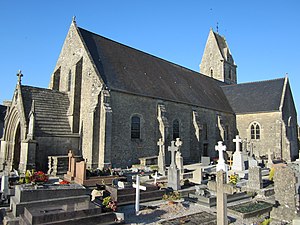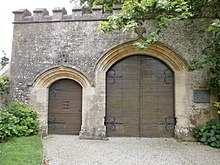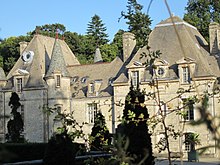Yvetot-Bocage
| Yvetot-Bocage | ||
|---|---|---|
|
|
||
| region | Normandy | |
| Department | Some | |
| Arrondissement | Cherbourg | |
| Canton | Valognes | |
| Community association | Cotentine | |
| Coordinates | 49 ° 29 ′ N , 1 ° 30 ′ W | |
| height | 39-75 m | |
| surface | 12.46 km 2 | |
| Residents | 1,145 (January 1, 2017) | |
| Population density | 92 inhabitants / km 2 | |
| Post Code | 50700 | |
| INSEE code | 50648 | |
| Website | www.yvetot-bocage.fr | |
 Saint-Georges church |
||
Yvetot-Bocage is a commune in the department of Manche in the region of Normandy .
geography
The municipality is located on the Cotentin peninsula .
Adjacent municipalities are:
Toponymy
Yvetot is derived from the Germanic words topt (village in Scandinavian) and Ivo (Germanic patronymic).
In 1919, Bocage was added so that the distinction could be made with other Norman parishes of the same name. The following hamlets also have a name of Scandinavian origin: la Brique, Grismarais, la Haulle, la Londe, Gargatte, la Mare, le Tot, Toves, Vic.
history
Yvetot limestone, known locally as Valognes Stone , has been mined since the 11th century and is used in most of the buildings in Yvetot and the surrounding area. From the 15th century, Valognes stone was used to decorate the interior and exterior of houses, where granite is more difficult to chisel. Valognes limestone was used until the 20th century.
On June 26, 1944, the surrender of Karl-Wilhelm von Schlieben was signed in the presence of Lawton Collins during the Battle of Cherbourg in the Castle of Servigny.
building
- Saint-Georges church included in the list of historical monuments. The church has a vaulted choir from the 13th century. The side aisle dates back to the 15th century. The nave was rebuilt in the 18th century. The building houses three statues, a triumphal beam and a pulpit , which are listed as objects.
The steeple was built in the 13th century and a chapel was added to the church in 1645.
- Servigny Castle, from the 16th century, rebuilt as a real castle in the 19th century. It was included in the list of historical monuments. The Servigny Treaty was signed on June 26, 1944 (see history section above). This is also where the plot of the book Le bonheur dans le crime by Jules Barbey d'Aurevilly takes place.
- Manoir de Mesnil, 17th century manor house, now used for agriculture.
- Azir, manor owned by Félix Vicq d'Azir .
- La Cour d'Yvetot, a former manor house.
- La Grande Londe, manor house.
- La Tuilerie, manor house built in 1810.
- Le Séminaire, former seminary.
- L'Épiscopat, former manor house of the coutancer bishops.
- Le manoir d'Yvetot, stately manor house.
- Montigny, manor house built 1654–1656.
- La Basfeuille, manor house.
- La Haulle, manor house.
- La Lande, house with an octagonal tower
Individual evidence
- ↑ René Lepelley. Dictionnaire étymologique des noms de communes de Normandie . Presses universitaires de Caen . Page 273. ISBN 2-905461-80-2
- ^ Église in the Base Mérimée of the French Ministry of Culture (French).
- ↑ See fr: poutre de gloire (in French) (cf. Triumphal Cross ).
- ↑ Œuvres mobilières à Yvetot-Bocage in the Base Palissy of the French Ministry of Culture (French).
- ^ Château de Servigny in the Base Mérimée of the French Ministry of Culture (French).



